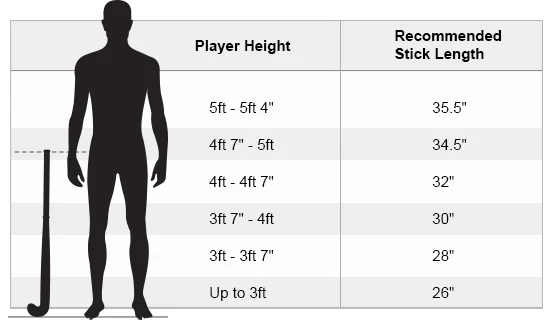Frequently Asked (Hockey) Questions
Choosing a stick size:
Stand Upright: Stand up straight with your dominant hand (the hand you use to hold the stick) by your side.
Place the Stick: Place the toe (the curved end) of the stick on the ground next to your foot. The stick should be perpendicular to the ground.
Positioning: Hold the stick upright so that the top of the handle is near your waist or hip bone.
Check Length: The ideal length of the stick should reach somewhere between your hip bone and the top of your hip. This is a general guideline, and some players may prefer a longer or shorter stick based on personal preference and playing style.
Consider Position: Different positions on the field may require slightly different stick lengths. For example, defenders may prefer a slightly longer stick for better reach, while attackers may opt for a shorter stick for better control and maneuverability.
Here is a guide to help

Hockey Stick Compostions
Hockey sticks are typically composed of several materials, each contributing to different aspects of the stick's performance. Here are the common materials used in the construction of hockey sticks:
Wood: Traditional hockey sticks were primarily made of wood, typically mulberry or hickory. Wood sticks are still used by some players, particularly beginners or those who prefer the feel of wood. They offer good control and a natural feel but may be heavier and less durable compared to modern materials. Fiberglass: Fiberglass is commonly used in hockey stick construction due to its lightweight and durability. It adds strength to the stick without significantly increasing its weight. Fiberglass-reinforced sticks offer a good balance of power and control. Carbon Fiber: Carbon fiber is a high-performance material known for its strength and lightweight properties. Carbon fiber sticks are popular among elite players due to their excellent power transmission and responsiveness. They provide a stiff and powerful feel, ideal for fast-paced gameplay and powerful shots.
Hockey Stick Shapes
In hockey, there are several stick shapes, each designed to suit different playing styles and positions. Here are some common stick shapes you might encounter:
Standard Bow: The standard bow, also known as the regular bow or mid-bow, is the most common shape for field hockey sticks. It features a gentle curve along the length of the stick, typically with the highest point of the curve positioned around the middle of the shaft. This shape provides a good balance between power and control, making it suitable for versatile play.
Low Bow: A low bow stick has a more pronounced curve compared to the standard bow, with the highest point of the curve positioned closer to the head of the stick. This shape helps players with drag flicks, aerials, and 3D skills by lifting the ball more easily and allowing for greater control when executing advanced techniques
Extreme Low Bow: The extreme low bow stick has an even more aggressive curve than the low bow, with the highest point of the curve positioned very close to the head of the stick. This shape is specifically designed for drag flick specialists and players who prioritize aerial skills and quick ball control. It facilitates powerful drag flicks and enhances maneuverability for players who need to execute precise dribbling and aerial passes.
Hockey Stick Weight
The choice between a light and a super-light hockey stick depends on various factors, including a player's playing style, position, and personal preferences. Both types of sticks offer distinct benefits, and the ideal choice often depends on individual needs and priorities. Here are some considerations for each:
Benefits of Light Sticks:
Agility and Maneuverability: Light sticks are easier to handle and maneuver, allowing players to quickly change direction, dribble with agility, and execute precise stick skills. This can be particularly advantageous for attackers and midfielders who rely on quick movements to navigate through defenders and create scoring opportunities.
Quick Stick Skills: Light sticks facilitate rapid stick movements, making it easier for players to perform quick passes, flicks, and shots. This agility and responsiveness can give players an edge in fast-paced gameplay situations, allowing them to react quickly and maintain control of the ball.
Reduced Fatigue: Lighter sticks can help reduce fatigue during extended periods of play, as they require less effort to swing and maneuver. This can be beneficial for players who need to maintain high levels of performance throughout a match without becoming overly fatigued.
Versatility: Light sticks are generally suitable for a wide range of playing styles and positions, making them a versatile choice for players who value adaptability and flexibility on the field.
Benefits of Super-Light Sticks:
Exceptional Agility: Super-light sticks offer even greater agility and maneuverability compared to standard light sticks, allowing players to make lightning-fast movements and react quickly to changes in play. This can be particularly advantageous for players who prioritize speed and agility in their playing style.
Improved Stick Skills: The reduced weight of super-light sticks enables players to execute intricate stick skills with precision and control. This can be advantageous for players who rely on technical proficiency and finesse to outmaneuver opponents and create scoring opportunities.
Quicker Reaction Times: Super-light sticks allow for faster reaction times, enabling players to respond more quickly to the movements of opponents and the trajectory of the ball. This can help players anticipate plays more effectively and maintain better positional awareness on the field.
Enhanced Shot Speed: The lighter weight of super-light sticks allows players to generate greater stick speed, resulting in more powerful shots and passes. This can be advantageous for players who prioritize shooting accuracy and velocity in their offensive play.
Ultimately, whether to choose a light or super-light field hockey stick depends on a player's individual preferences, playing style, and positional requirements. Trying out different sticks and assessing how they feel and perform on the field can help players determine which type of stick best suits their needs.


